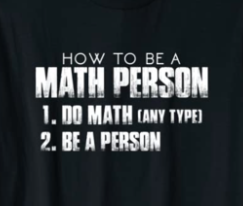Hyla Stories
The Life Mathematical

One of the core beliefs underpinning Hyla’s high school math program is that mathematics is a human pursuit akin to art, music and literature. And, just as when we become artists, musicians and writers when we draw a picture, sing along or pen a love letter, so too when we do mathematics we become mathematicians.
To help students see more clearly this human side of math we recently introduced them to a charming BBC podcast called The Life Scientific. In each episode an accomplished scientist or mathematician is interviewed, sharing their intellectual struggles and also providing an intimate picture of themselves as a human being. Many speak of the challenges they faced in school and what motivated them to keep on pushing forward. ALL of the interviewees share the passion they continue to feel for their research.
Here are five interviews with research mathematicians that are well worth a listen:

Fry describes her love of Formula 1 racing and the influence her mom had on her studies. After a terrible experience at a math conference in Berlin, Fry was moved to change her research focus to the ethical implications of machine learning and big data.

Cheng explains how she came to study her highly abstract field of mathematics, looking at the math of math itself, as well as her love of music. More recently, Cheng has turned her attention to ridding the world of math anxiety through baking!

Du Sautoy talks about his passion for the performing arts, as well as the mathematics of symmetry; and why, for him, mathematics is as much a creative art as a science.

Chamberlain describes how his parents supported his drive to become a mathematician, even in the face of opposition or indifference from his teachers. He now shares the mantra he learned from his parents with his own children: “You don’t need anyone’s permission to be a great mathematician!”

Stewart connects his research in the mathematics of biology to his work as a writer. He has written a series of books popularizing big ideas and outstanding puzzles in math and science, as well as works of science fiction.
The skills behind the stories
As students meet mathematicians and scientists and learn their stories, they are also learning important math skills. Take a look:
Math 300/301: In Advanced Math students are expanding their toolkit for using exponential and logarithmic functions, and beginning to explore the power of parametric equations. They will be:
- Applying exponential functions to model everyday situations.
- Exploring Euler’s number, e, and its use in financial and natural models.
- Using properties of logarithms to solve problems.
- Transforming graphs for the family of logarithmic functions.
- Defining the motion of an object using parametric equations.
- Using parametric equations to solve everyday problems.
Math 200/201: In Math 2, students are exploring graphical/statistical representations of data spread by:
- Creating box-plots and relative frequency histograms to visualize raw data
- Calculating, both manually and using a graphing calculator, measures of central tendency and measure of data spread.
- Describing data using a normal distribution to find the proportion of a population with certain characteristics.
- Employing a z-table to analyze z-scores and percentages.
- Evaluating combination and permutations to quantify the ways a subset of objects can be selected from a set.
- Using simulations of probability to describe independent/dependent and mutually exclusive events.
Math 100/101: Students in Math 1 have begun investigating quadratic expressions and functions and are expanding their study of trigonometric functions. They will be:
- Using area models to factor and expand quadratic expressions.
- Describing quadratic functions with words, graphs, tables and equations.
- Solving quadratic equations by completing the square and by applying the Quadratic Formula, and developing strategies to choose the best method to solve problems involving quadratic functions.
- Using trigonometric ratios (tangent, sine, cosine, and their inverses) to solve for missing measurements in right triangles.
- Modeling and answering questions about everyday situations using quadratic functions and right triangles.
Math 050: In Foundational Math we have turned our attention to statistics, and:
- Representing a distribution of data graphically.
- Choosing the best method to describe the center, shape, spread, and outliers of a distribution of data depending on the shape of the distribution.
- Describing a distribution of data using numerical measures.
- Understanding the benefits and dangers of using numerical measures to summarize data.
